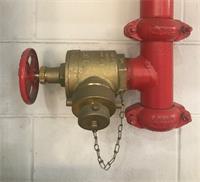What Do NFPA 14 and NFPA 13 Say About Hose Connections?

What Do NFPA 14 and NFPA 13 Say About Hose Connections? by Terin Hopkins
This use of hose connections on sprinkler systems has caused confusion in the fire service by not recognizing that not all hose connections in a building are created equal. Some are hose connections simply installed on sprinkler systems with an added inside hose stream allowance. This allowance only provides a minimal additional water supply not intended to provide the required flow for fire operations. It is intended for ancillary occupant use or for mop-up after a fire.
Inside hose stream allowance is the amount of additional water that is added to the sprinkler hydraulic calculation design, when hose connections are added on a sprinkler system inside a building. The allowance found in NFPA 13 Standard for the Installation of Sprinkler Systems (2019), Section 19.2.6.3 is added based on the amount of hose connections installed within the building, based on 50gpm increments. While this is allowed by the standard, there is no current code requirement for the installation of hose connections on an automatic fire sprinkler system used for structural firefighting.
Over the years we continue to see local jurisdictions require these hose connections in buildings, equipped with only automatic fire sprinkler systems, which do not have a requirement for a standpipe system. This is often done as an attempt to provide hose connections in areas of a building that might benefit or appear to need hose connections but do not have a code requirement for them.
This is often the case with two and three-story buildings without a standpipe requirement, but belief is that there would be a benefit from the installation of hose connections. Unfortunately, these hose connections will not provide the pressure and flow required for interior structural firefighting. The use of operational fire hose on this system may in fact utilize more water than provided for at the hose connection, thus having a negative effect on the fire sprinkler system operation.
It is imperative to ensure an adequate water flow is available for the sprinkler system to operate correctly when a hose connection is added on the system and used simultaneously. It is equally important to understand that while NFPA 13 allows hose connections to be added, it does not meet the required flow needed for interior structural firefighting.
These systems are also often improperly designated as sprinkler-standpipe combination systems, adding to the design confusion. There are no current requirements for hose connections to be added to automatic fire sprinkler systems.
NFPA 14 Hose Connections
 While other hose connections are designed to the requirements of NFPA 14 Standard for the Installation of Standpipes and Hose Systems, we must understand that even when designed to NFPA 14, not all standpipe hose connections meet the standard required flow for interior structural firefighting. Class I standpipes are designed expressly for the purpose of providing that required flow.
While other hose connections are designed to the requirements of NFPA 14 Standard for the Installation of Standpipes and Hose Systems, we must understand that even when designed to NFPA 14, not all standpipe hose connections meet the standard required flow for interior structural firefighting. Class I standpipes are designed expressly for the purpose of providing that required flow.
Class II standpipes are obsolete and were only designed for trained fire brigades to contain fires in the incipient phase, once again not meeting the requirement for flow needed for interior structural firefighting.
Currently there is no code requirements for the installation of a Class II standpipe. While Class III have both 1 ½ in. and 2 ½ in. hose connections, only the Class I portion meets the flows required. In most cases where Class III standpipes are required by the code, there are exceptions allowing for only the Class I portion to be installed.
Combined Sprinkler-Standpipe Hose Connections
Combined sprinklers-standpipes systems only share a common water supply riser. The hydraulic system demands are done separately to the individual standard. Combined sprinkler-standpipe systems must meet the installation requirements for both NFPA 13 and NFPA 14.
NFPA 14, Section 7.10.1.3.1.1, includes hose stream demand in the sprinkler side of the calculation, but allows either the sprinkler plus hose demand, or the standpipe demand to be used, whichever is greater. In most combined sprinkler-standpipe systems, the standpipe demand will always be greater. These systems are designed to provide the required flow for interior structural firefighting.
